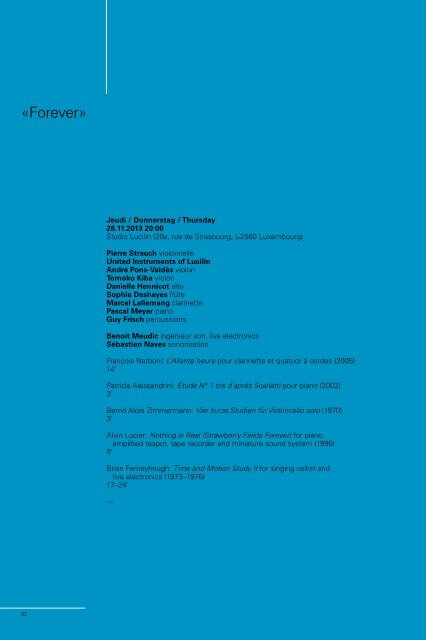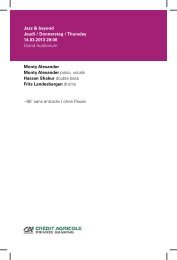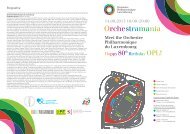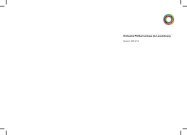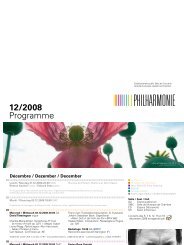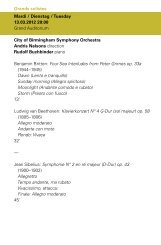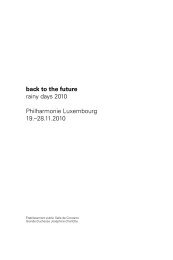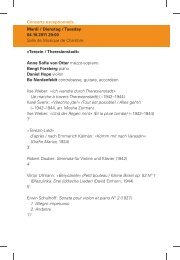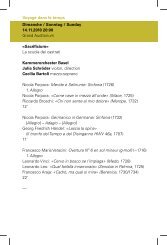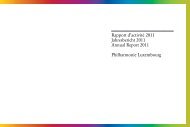Abendprogramm (PDF) - Philharmonie Luxembourg
Abendprogramm (PDF) - Philharmonie Luxembourg
Abendprogramm (PDF) - Philharmonie Luxembourg
You also want an ePaper? Increase the reach of your titles
YUMPU automatically turns print PDFs into web optimized ePapers that Google loves.
«Forever»<br />
Jeudi / Donnerstag / Thursday<br />
28.11.2013 20:00<br />
Studio Lucilin (20a, rue de Strasbourg, L-2560 <strong>Luxembourg</strong>)<br />
Pierre Strauch violoncelle<br />
United Instruments of Lucilin<br />
André Pons-Valdès violon<br />
Tomoko Kiba violon<br />
Danielle Hennicot alto<br />
Sophie Deshayes flûte<br />
Marcel Lallemang clarinette<br />
Pascal Meyer piano<br />
Guy Frisch percussions<br />
Benoit Meudic ingénieur son, live electronics<br />
Sébastien Naves sonorisation<br />
François Narboni: L’Allante heure pour clarinette et quatuor à cordes (2005)<br />
14’<br />
Patricia Alessandrini: Étude N° 1 bis d’après Scarlatti pour piano (2002)<br />
3’<br />
Bernd Alois Zimmermann: Vier kurze Studien für Violoncello solo (1970)<br />
3’<br />
Alvin Lucier: Nothing is Real (Strawberry Fields Forever) for piano,<br />
amplified teapot, tape recorder and miniature sound system (1990)<br />
8’<br />
Brian Ferneyhough: Time and Motion Study II for singing cellist and<br />
live electronics (1973–1976)<br />
17–24’<br />
—<br />
92
Mathias Spahlinger: vorschläge. konzepte zur ver(über)flüssigung der<br />
funktion des komponisten (1992)<br />
eigenzeit<br />
innere uhr<br />
kairos<br />
eigentempo<br />
~15–25’<br />
Christoph Herndler: 2 Minuten für Flöte, Klarinette, 2 Violinen, Viola<br />
und Percussion (2000/2013, commande / Kompositionsauftrag<br />
<strong>Philharmonie</strong> <strong>Luxembourg</strong>, création / Uraufführung)<br />
2’<br />
John Cage: One 3 = 4’33” (0’0”) + for performer (1989)<br />
Note:<br />
= Sofia Gubaidulina (There Is An Inner Clock)<br />
III International Music Festival in the USSR<br />
Christoph Herndler: 6 Minuten für Cello und Klavier (2000/2013, commande /<br />
Kompositionsauftrag <strong>Philharmonie</strong> <strong>Luxembourg</strong>, création / Uraufführung)<br />
6’<br />
Olivier Messiaen: Quatuor pour la fin du temps (1941)<br />
5. Louange à l’Éternité de Jésus pour violoncelle et piano<br />
8’<br />
En coopération avec United Instruments of Lucilin<br />
93
«Forever»<br />
Temps + musique = une soirée thématique au studio Lucilin<br />
Zeit + Musik = ein Themenabend im Studio Lucilin<br />
François Narboni: L’allante heure<br />
À la fois semblable et recommencée sans cesse, L’allante heure est une mélodie<br />
infinie. Déroulée toujours à la clarinette, elle est réverbérée par les instruments<br />
du quatuor qui en prolongent chaque note. Ainsi se crée une trame harmonique<br />
dense, intemporelle, aux transformations lentes, comme un nuage qui passe dans<br />
le ciel. Quand, dans le débordement du violoncelle, la musique s’arrête à la fin,<br />
c’est comme si la mélodie, jamais interrompue, continuait de bruisser dans nos<br />
mémoires…<br />
L’allante heure est dédiée à Betsy Jolas pour ses 80 ans. (François Narboni)<br />
Patricia Alessandrini: Étude N° 1 bis d’après Scarlatti<br />
Étude N° 1 bis (d’après D. Scarlatti) was added to the existing Trois études for the<br />
Weekend Domenico Scarlatti of Strasbourg in February 2002, and premiered by<br />
Michelle Malick in the first concert of this series, «Affinités Italiennes». It takes<br />
materials directly from an existing work, Domenico Scarlatti’s Sonata N° 10 in<br />
d minor, book I: the upper voice of the polyphonic line of the first measures<br />
is isolated in notes played directly on the strings (pizzicato, with glissandi),<br />
and the sequence of 32-note figures appears in its entirety. The interest of the<br />
piece lies not so much in the gestures themselves, but in the changes of colour<br />
that take place in the spaces between them. In terms of the original idea of the<br />
Trois études as a study of extended techniques, the pedagogic goal is in part the<br />
execution of notes directly on the strings, but also a fine control of weight of<br />
attack, as one must frequently depress notes silently as well as play with the<br />
double échappement, pressing the notes half-way down before playing in order to<br />
produce muted attacks. (Patricia Alessandrini)<br />
Bernd Alois Zimmermann: Vier kurze Studien<br />
In seinem 1957 geschriebenen Text «Intervall und Zeit» brachte Bernd Alois<br />
Zimmermann den rasanten Pluralismus der Wirtschaftswunder-Zeit auf den<br />
Punkt – beziehungsweise auf die Kugel: Im Begriff von der «Kugelgestalt der<br />
Zeit» machte er die Einheit von Vergangenem, Gegenwärtigem und Zukünftigem<br />
anschaulich. Philosophisch untersuchte er den Unterschied zwischen effektiver<br />
und erlebter Zeit und setzte sich dabei mit Zeittheorien von Plato, Aristoteles,<br />
Augustinus, Leibniz, Husserl, Heidegger u.v.a. auseinander. Praktisch setzte er<br />
seine Philosophie des gleichzeitigen Zugriffs auf die gesamte historische Zeit um<br />
in Kompositionen wie der nur aus Zitaten quer durch die ganze Musikgeschichte<br />
bestehenden Musique pour les Soupers du Roi Ubu von 1966 – eine zynische, laute,<br />
grellbunte Collage mit dem Untertitel «Ballet noir» (vgl. das «Portrait Bernd Alois<br />
Zimmermann» im Festival rainy days 2008).<br />
In der Einführung zu seiner Oper Die Soldaten (1957–1964) nach dem Drama von<br />
Jakob Michael Reinhold Lenz (1776) schrieb er:<br />
«Das Erregendste für mich war wohl vor allem der Lenzsche Gedanke von der Einheit<br />
der inneren Handlung, welcher die ‹Soldaten› in so unerhörter Weise bestimmt und Lenz<br />
veranlaßte, sich von der ‹jämmerlich berühmten Bulle der drei Einheiten› (nämlich des<br />
Linke und übernächste Seite:<br />
Brian Ferneyhough: Time and<br />
Motion Study II for solo cello<br />
and electronics, letztes Blatt<br />
© C.F. Peters, Frankfurt /<br />
Leipzig / London / New York<br />
95
Ortes, der Handlung und der Zeit) loszusagen. Konsequent werden bei Lenz also die<br />
drei klassischen Einheiten negiert, mehrere Handlungen übereinander geschichtet. Eine<br />
Vorwegnahme des Joyceschen ‹Stundentanzes der Simultaneität›. Der Schritt von der<br />
Dramaturgie des Sturm und Drang zur Jetztzeit ist erstaunlich klein: Aufhebung der drei<br />
Einheiten führt stracks zur Aufhebung von Raum und Zeit, befindet sich im Innern der<br />
‹Kugelgestalt der Zeit›: Zukunft, Gegenwart und Vergangenheit werden vertauschbar.»<br />
(Bernd Alois Zimmermann: Intervall und Zeit. – Mainz: Schott, 1974, S. 114)<br />
In den Vier kurzen Studien für sein erklärtes Lieblingsinstrument, das Violoncello,<br />
kommt er kurz vor seinem Freitod am 10. August 1970 noch einmal auf sehr<br />
subtile Weise auf das Thema Zeit zurück. Die vier kurzen Stücke sind eine<br />
konzentrierte, minimalistische Übung im musikalischen Umgang mit Tempo<br />
und Dauern. Innerhalb kürzester Zeit prallen extrem unterschiedliche Tempi und<br />
Geschwindigkeiten aufeinander. Im deutlichen Kontrast zur Form eines ‹Leipziger<br />
Allerleis› (wie sich etwas respektlos der Umgang mit unterschiedlichen Dauern<br />
in manchen Stücken der seriellen Musik beschreiben ließe) komponiert er aber<br />
hier gewissermaßen vier kurze Charakterstücke, die durch extrem unterschiedliche<br />
Zeitmaße geprägt werden.<br />
I Zwei verschiedene Stricharten für die verschiedenen Saiten oder zwei verschiedene<br />
Klangarten bei gleicher Strichart.<br />
Tempo: von langsam bis so schnell wie möglich.<br />
II Pizzicato-Studie unter Verwendung von Natur-Flageoletttönen in beliebigem Tempo,<br />
immer klingendes Pizz.<br />
III Tempo: sehr schnell<br />
IV Hohe Lagen, so langsam wie möglich. Dauer nach Abstand [der Noten].<br />
(Bernhard Günther)<br />
Alvin Lucier: Nothing is Real (Strawberry Fields Forever)<br />
Im Frühling 1990 bat mich die Pianistin Aki Takahashi, ein Klavierarrangement<br />
eines Beatles-Songs für sie zu schreiben. Sie hatte erfolgreich Musik von Erik<br />
Satie auf CD herausgebracht und die Plattenfirma bat sie, als Nächstes eine<br />
Sammlung von Lennon- und McCartney-Melodien einzuspielen. Sie nahm unter<br />
der Bedingung an, dass sie sich die Komponisten selbst aussuchen könne, die die<br />
Arrangements schrieben. Da ich mich nicht selbst auf ein bestimmtes Lied und<br />
die daran geknüpfte Stimmung und Erwartung festlegen lassen wollte, bat ich sie,<br />
ein Lied für mich auszusuchen. Sie wählte «Strawberry Fields Forever». Als ich sie<br />
fragte, warum sie gerade dieses Lied ausgesucht hatte, antwortete sie, die Textzeile<br />
«Nothing is real» erinnere sie immer an meine Musik.<br />
Melodiefragmente werden gespielt, als Cluster ausgehalten und mit einem<br />
Cassettenrekorder aufgenommen. Nach dem Ende dieses Teils wird das<br />
Band zurückgespult und durch einen kleinen Lautsprecher in einer auf dem<br />
geschlossenen Klavier stehenden Teekanne wieder abgespielt. Während des<br />
Abspielens wird der Teekannendeckel gehoben und gesenkt und zweimal<br />
die Teekanne vom Klavier genommen, wodurch sich die Klangcharakteristik<br />
verändert. (Alvin Lucier, 1990)<br />
Finally, I decided to play the sounds into a teapot, which is a little object with<br />
treasure value to many people. The resonances of the pot would reinforce certain<br />
pitches of whatever song I used. I had done something like that in Chambers<br />
where sounds are played into small resonant objects.<br />
My first attempt was a piece I called Any Beatles Song. The score simply told the<br />
player to play any Beatles song into the teapot, record it, rewind the tape and play<br />
it back. I thought that would be it. One would play the song three or four times<br />
in different keys so that most of the regions of the piano would be covered. You<br />
would be testing the resonances of the pot as well. But when Aki came over to<br />
visit me a few months later, she said she didn’t really know what to do, she was<br />
uncomfortable making so many choices. I think that she was secretly telling me<br />
that she didn’t think the piece was finished. That was fine with me; I like it when<br />
players are honest with me. So I worked on it some more and finally came up<br />
96
with the finished version, but I still asked Aki to choose the song. I didn’t want<br />
to choose one, I don’t know why. Perhaps I didn’t want to point to a particular<br />
mood or sentiment, but simply to work with tones. She chose «Strawberry Fields<br />
Forever». When I asked her why, she said that the line «Nothing is real» reminded<br />
her of my music. It’s strange because we had been discussing standing waves,<br />
room resonances, all these real phenomena. I broke up the melody into fragments<br />
that are held as clusters. It can be played with one hand.<br />
(Alvin Lucier: Reflections/Reflexionen – Interviews, Scores, Writings. – Köln: MusikText, 2005)<br />
Brian Ferneyhough: Time and Motion Study II<br />
I.<br />
In the first instance this work is concerned with memory, with the manner<br />
in which memory sieves, colours and reorders that which is registered by the<br />
senses. A second level concerns itself with the construction of a model designed<br />
to demonstrate the fact that memory is discontinuous: something having a<br />
decided effect on perception, on the one hand in the form of ever-increasing<br />
«interference» in development, on the other as a necessary precondition for the<br />
historical consolidation of the individual. Point of departure for this specific<br />
confrontation: a detailed examination of the nature of time and the abolition of<br />
the linear experiencing of time in the process of recall. The work itself is thus to<br />
be regarded as «the memory of a production process», the place of performance<br />
as the point of confrontation of objective (measurable) systems and subjective<br />
obscuration and elimination (these latter by no means invariably predictable<br />
in terms of their ensemble effect). The function of these subjective processes<br />
is to (re-)present and idealized projection of experiential fragments which, at<br />
some point in the future, will, by means of individual recollective mechanisms,<br />
withdraw themselves effectively from the sphere of objectively measurable<br />
temporality. As is the case in the other works sharing the present title (Time and<br />
Motion Study III, Donaueschingen, 1975) continual reference to the concept<br />
of (industrial) efficiency serves to underline the goal-directed nature of this<br />
nonsystematical disturbance/destruction of the reservoir of experience (itself<br />
merely superficially controlled by the intellect). This goal-directed aspect is then<br />
investigated, in order to discover to what extent the individual is disorientated,<br />
oppressed and, finally, amokeilated by the complexities of the permanent (and<br />
deadly) battle between history as immediate experience and the prescriptive<br />
conventions imposed on this latter by public discourse («history»). Paradoxically,<br />
it seems only possible to imagine a temporal contiuum via the decay of single<br />
instants, via the absorption of the discrete instant in the totality, but also the fact<br />
that this decay conditions the future which is born of it.<br />
The fabric of the piece consists of a continuous sequence of overlapping processes<br />
which, in ever-different quantities, are allowed to proceed both simultaneously<br />
and consecutively. These processes lead in turn to the accumulation of a residual<br />
«sediment». Although the essential nature of the processes dictates that these<br />
finely-sieved layers are produced as the result of several generative procedures,<br />
in practice they have been so reduced to a common denominator by means of<br />
the above-mentioned «sieving» that a continuum characterized by a constant<br />
consistency is produced. It would be false to assume that the original processes<br />
represent mere tools, which, although necessary, are, in the last analysis, not<br />
decisive. In contrast to the usual view of a «work», that which is heard is to be<br />
understood as the «sounding trace», the spoor, of the mechanisms for which it<br />
stands. Thus it is intended that not only the experiential time of the performance<br />
itself, but also the «real time» involved in the act of composition is to act as the<br />
measure of significance. One has to dig out, analyse, project back. Whilst the work<br />
can in no sense said to be improvisational, neither the cellist nor the operators<br />
of the electronic equipment whose work must be coordinated with his, the fact<br />
that the piece resists being relegated to the status of a product, of something<br />
static, leads to it being transformed into a symbol for something provisional i.e.<br />
for the conception of the self-suspended in every moment between decay and<br />
consolidation.<br />
98
II.<br />
Not the least obvious of associations suggested by the almost organic relationship<br />
existing between performers and electronics (one of the central points of reference<br />
in Time and Motion Study II) is that of various varieties of execution… The<br />
role of the electronic layout is not restricted here to such tasks as completion,<br />
commentary or support, but, on the contrary, it assumes the position of a weird<br />
«double» (Doppelgänger). Although the electronic equipment offers the texture<br />
the opportunity for self-reflection via repetition, it is only very seldom that the<br />
elements designated for repetition seem willing to subordinate themselves to the<br />
continually unfolding live material.<br />
Because of this, the repetition process frequently brings with it a darkening, a<br />
disturbing, which forms the opposite pole to the highly systematised methods<br />
by means of which the material to be repeated was selected. Repetition as<br />
precondition for a context (continuity): repetition as something superfluous<br />
(leading to fragmentation). Seen from another point of view, one might interpret<br />
this encounter between the self-expression of the individual and the distorting<br />
mirror of collectivity (continually frustrating the desire of the performer to speak<br />
freely) as throwing a little light on the relationship (in the meantime becoming<br />
symbiotic) between the individual and the public spheres of experience.<br />
III.<br />
The work may be conceived of as the interaction, interpenetration and mutual<br />
assimilation of two distinct types of material. The main material consists<br />
of seven times seven rhythmic formulas which ordain the course of events<br />
through a process of continual variation, and in combination with a rigorously<br />
predetermined pattern of phrase-lengths. It is in passages organised according to<br />
these principles that the measurable aspect of time assumes particular importance.<br />
The secondary material consists of a series of individual commentaries on six<br />
distinct basic articulation types – organisms characterised by a much lesser degree<br />
of precompositional definition (i.e. a higher degree of initial abstraction) than is<br />
the case for the other material. There are six examples of between three and six<br />
types in a particular sequence, the unit of form. Each sequence is in turn more<br />
clearly characterised by the predominance within it of one or more main types.<br />
Pitch organization in these sections of the work is less perceptibly fixed in advance<br />
than is the case elsewhere: throughout the composition, pitch organization is<br />
sharply divided into a strict and rigid selection procedure for the main sections<br />
and a method allowing greater and lesser amounts of choice in context (although<br />
the relative degree of choice admitted is also fixed in advance) for the sequences.<br />
The opening of the piece consists of a lengthy passage in which interlocking<br />
fragments of the two basic material categories are «analysed apart» by means<br />
of two tape delay systems with the aid of which the sequences are recorded on<br />
tape during the course of the performance by the assistants and, after a delay<br />
of several seconds, are played back (with a variable degree of distortion arising<br />
from manipulation of the recording volume-control) over whatever the cellist is<br />
playing at the moment. Again and again these fragments serve to hinder the free<br />
unfolding of the live material by reason of their «non-functional» nature. Even<br />
though the main material – at first restricted to scraping and other «impure»<br />
sounds – is not treated in this fashion, it is nevertheless recorded on a further<br />
tape (without the sequences) so that it might be played back at the end of the<br />
composition as part of a pyramidal piling up of sound-strata. After the negotiation<br />
of several intervening episodes, the middle of the work is signaled by another<br />
sort of auto-analysis. At that point rapidly alternating groups of long, held<br />
notes and short, explosive figurations are divided up and assigned, according<br />
to playing technique («arco» or «pizzicato»), to either the lefthand or righthand<br />
loudspeakers, where they are subsequently combined in the stepwise construction<br />
and demolition of superimposed blocks of chordal structures. It is here that the<br />
«optimistic/constructive» potential of the electronic medium is deliberately and<br />
clearly exhibited, even though in practice the clarity is increasingly compromised<br />
by the inevitable errors and differing speeds of reaction on the part of the cellist<br />
99
when called upon to insert new elements into a progressively more impenetrable<br />
texture. The second half of Time and Motion Study II, beginning directly after<br />
this point, witnesses the rapid climb to predominance of the tendency towards<br />
entropy inherent in the method of electronic intervention employed. In his<br />
desperation in the face of the sudden increase in the amount of superfluous<br />
«memory fragments» hemming him aurally in, the cellist commences a «dialogue»<br />
with the apparatus and the sounds which torture and frustrate him. The text<br />
(reduced to a string of key words) deals with the impossibility of attaining a<br />
harmony between words and emotional states: in accord with the broken link<br />
and its attendant frustrations, the vocal contribution is sucked up immediately<br />
into the electronic systems. Distorted by means of a ring modulator connected<br />
to the cello and, finally, played back on top of the live material in the form of<br />
«interference», robbed of all communicative content. The cellist plays without<br />
electronic commentary at only one moment, and that right at the end. Having<br />
at last achieved a degree of independence, the cellist finds himself reduced to<br />
endlessly repeating slight variations of the same meaningless tone. The absurdity<br />
of the situation is underlined by the fact that the performer is condemned to<br />
continue to the bitter end in the certain knowledge that all recorded tapes – his<br />
«memory» – are being silently erased behind his back.<br />
IV.<br />
The parallel functions of the complimentary constituents of the instrumental<br />
layout might be schematically illustrated somewhat as follows:<br />
Instrument<br />
Electronics<br />
live performance amplification<br />
singing/speaking ring modulation<br />
foot pedals<br />
«sound analysis» (e.g. varying of volume)<br />
Page de droite / Rechte Seite:<br />
take your time<br />
photo: étudiants du Lycée<br />
Technique des Arts et Métiers<br />
<strong>Luxembourg</strong>-Limpertsberg<br />
(LTAM), voir p. 2 / siehe S. 2<br />
The various extremes are linked by means of the almost continuous deployment<br />
of delay tapes and feedback (superposition). With one single exception (the modulation<br />
of voice with instrument) all modifications of timbre are achieved purely<br />
by means of the «amplified natural sounds» produced by the contact microphones<br />
attached to the body of the instrument. As one of these microphones is fixed<br />
under the fingerboard, and both are independently controlled by the two footpedals<br />
operated by the cellist, it is clear that not only degree of loudness but also<br />
distribution between the antiphonally-placed loudspeakers and timbre of the<br />
amplified result are dependant on the position of the pedals at any given instant.<br />
The manipulation of these latter in respect of every note is indicated in the score.<br />
In addition there are two further microphones: one placed so as to record the live<br />
cello sounds, the other affixed to the throat of the performer. The signals from<br />
these are fed into the ring modulator as mentioned further above.<br />
Because the cellist is to master and reproduce information of high complexity<br />
(notated at times on five simultaneous systems) he is at all times forced to<br />
invest his entire energy in order to even approach an adequate interpretation.<br />
At the same time the assistants are occupied with transforming, selecting and<br />
reorganizing that which emerges from this production-process. In the same<br />
manner as the foot pedal instructions for the cellist, the exact information for<br />
each assistant is included in the score. Because of the nature of the delay-tape<br />
layout, certain elements are only partially reproduced, other reproduced in a<br />
totally different order from the one in which they were performed. As with<br />
human memory the supposed linearity of time is here abolished, its constituent<br />
ciphers are delivered up to the simultaneity of the individual consciousness…<br />
Whilst doubtless a very pessimistic piece, Time and Motion Study II is by no means<br />
nihilistic; its negativity does not stem from the relentless pursuit of some aesthetic<br />
«burntearth» policy, but rather from the desire to clear the ground in order that<br />
one may begin to build anew. It offers no solutions for overcoming the lyrical<br />
impasse, but neither does it deny meaningfulness to the attempt…<br />
(Brian Ferneyhough / © C.F. Peters, Frankfurt / Leipzig / London / New York)<br />
100
101
Je veux chanter un air<br />
que je connais: avant de<br />
commencer, mon attente<br />
se porte sur l’air pris dans<br />
son ensemble. Lorsque j’ai<br />
commencé, tout ce que<br />
j’en laisse tomber dans le<br />
passé vient charger ma<br />
mémoire. L’activité de<br />
ma pensée se partage en<br />
mémoire par rapport à ce<br />
que j’ai dit et en attente par<br />
rapport à ce que je vais dire.<br />
Cependant, c’est un acte<br />
présent d’attention qui fait<br />
passer ce qui était futur à<br />
l’état de temps écoulé. Plus<br />
se prolonge cette opération,<br />
plus l’attente est abrégée et<br />
plus la mémoire s’accroît,<br />
jusqu’au moment où l’attente<br />
est complètement épuisée,<br />
l’acte étant terminé et passé<br />
tout entier dans la mémoire.<br />
Et ce qui a lieu pour l’air<br />
pris dans son ensemble a<br />
lieu pour chacune de ses<br />
parties, pour chacune de<br />
ses syllabes, et aussi pour<br />
un autre acte plus étendu<br />
dont cet air n’est peut-être<br />
qu’une petite partie. Il en est<br />
de même de la vie entière<br />
de l’homme, dont les actions<br />
humaines sont autant de<br />
parties et enfin de la suite<br />
des générations humaines,<br />
dont chaque existence n’est<br />
qu’une partie.<br />
(Extrait de: Saint-Augustin,<br />
Les Confessions, livre<br />
onzième, chapitre 28: «Nous<br />
mesurons l’avenir par le<br />
temps». –<br />
Traduction: Joseph Trabucco<br />
© Flammarion, coll. «GF»,<br />
p. 271–273. Avec l’aimable<br />
autorisation des éditions<br />
Flammarion, Paris.)<br />
Mathias Spahlinger: vorschläge. konzepte zur ver(über)flüssigung<br />
der funktion des komponisten<br />
auf die vorschläge folgen die hauptnoten. besser noch, die unterscheidung zwischen<br />
haupt- und nebengedanken, rede, nachvollzug und gegenrede wäre allenthalben<br />
«temporär und gradweise» (hölderlin), mithin durchschaubar, austauschbar,<br />
aufhebbar.<br />
diese konzepte möchten etwas beitragen zur verallgemeinerung des einstweilen<br />
einseitigen rechts, sich etwas einfallen zu lassen. bei deren ausarbeitung habe ich<br />
mich von einigen vorüberlegungen leiten lassen, die ich mitteilen will, um sie<br />
zur diskussion zu stellen und um offenzulegen, daß meine vorschläge keineswegs<br />
immer allen meinen eigenen forderungen genügen. damit ist zugleich die richtung<br />
angedeutet, in die ich mir vorstelle, daß gedanken dieser art weiterentwickelt<br />
werden könnten:<br />
diejenigen spielregeln sind die besten (und am schwersten zu formulieren), die<br />
nach vorne offen sind, ihre reflexion erheischen oder voraussetzen, in denen ihre<br />
selbstaufhebung, ihre verflüssigung und verüberflüssigung angelegt ist. spielregeln<br />
für musik, seien sie vom komponisten als anregung vorgegeben oder aufgrund<br />
von oder ohne eine anregung gemeinsam entwickelt, sollten nicht am resultat<br />
orientiert sein, nichts haben von strikt zu befolgender verkehrsordnung, sondern<br />
in jedem augenblick ihrer ausführung zur disposition stehen. die regel soll beeinflußbar,<br />
veränderbar, ja abschaffbar sein und es kann, auch wenn ihre geltung<br />
erhalten bleibt, gegen sie verstoßen werden; es wird sich zeigen, daß ein gezielter<br />
regelverstoß mehr wahrheit ans licht bringt, als eine regel jemals haben kann, oder<br />
andere, nicht vorformulierte gesetzmäßigkeiten sollen durch proben oder ad-hocentscheidungen<br />
überhaupt erst entstehen, wogegen, zum besseren des ganzen,<br />
wiederum einspruch, widerspruch möglich und erwünscht ist. was diese musik<br />
darstellt, ausdrückt, ist, bestimmen die ausführenden und zwar jede/r von ihnen.<br />
entscheidungen fordern sachverstand, sie wollen so abverlangt sein, daß sie auf<br />
jeder stufe der bildung möglich sind, praktiziert und geübt wird die künstlerische<br />
kompetenz vor der spezifisch musikalischen, die musikalische vor der instrumentalen<br />
oder der handwerklichen, die immer an ein relativ fixiertes regelwerk gebunden<br />
ist. nebenbei bemerkt soll die ästhetische entscheidungsfreiheit auch nicht<br />
durch gesellschaftsspielregeln zurückgepfiffen werden, es geht um musik. nur wo<br />
soziale prozesse nahezu unmittelbar klangliche sind, dürfen sie in den vordergrund<br />
treten. pädagogik und didaktik haben in der regel lernziele, und es ist dem, der<br />
etwas weitergeben möchte, unendlich schwer, besserwisserei zu vermeiden, sie ist<br />
das gegenteil von ästhetischer erfahrung. ich habe versucht, nur solche konzepte<br />
aufzuschreiben, an deren realisierung ich selbst gerne mitarbeiten würde.<br />
das altgriechische wort schule heißt auch: muße, freie zeit, (philosophische und<br />
gelehrte) gespräche; und langsamkeit, verzug, müßiggang, saumseligkeit, hierin<br />
steckt das schwer zu ertragende privileg, von der sogenannten nützlichen arbeit<br />
freigestellt zu sein und die erfahrung, daß die lernenden, denkenden, musizierenden<br />
dem ziel am nächsten kommen, wenn sie es nicht vor augen haben.<br />
absichtslosigkeit, wie sie die ausführung dieser konzepte braucht, ist mit passivität<br />
oder fatalismus nicht zu verwechseln; sie war schon immer eine künstlerische und<br />
denkerische tugend und sollte eine soziale sein. gegenwärtig scheinen die chancen<br />
nicht groß, daß in absehbarer zeit der wille jeder/s einzelnen, ihre/seine wünsche<br />
und träume richtig und wahr werden. ein selbstbeobachtendes, auch kritisches<br />
verhältnis zum eigenen willen, zu dem seinen und zu den seinen zu kommen,<br />
ohne sich durchzusetzen, will geübt sein. fangen wir ruhig damit an, obwohl und<br />
weil es vielleicht zu spät ist. wir werden sehen, wie hölderlin sagte, daß der freiere<br />
auch der innigere zusammenhang ist.<br />
die vorschläge können in jeder beliebigen auswahl, reihenfolge und kombination,<br />
auch synchron, ausgeführt werden, einzelne konzepte können bestandteile von<br />
anderen sein oder andere beinhalten, insbesondere jede form der variantenbildung<br />
und weiterentwicklung ist erwünscht.<br />
(mathias spahlinger: vorschläge [Vorwort der Partitur]. – Wien: Universal Edition, 1992)<br />
102
Christoph Herndler:<br />
2 Minuten für Flöte, Klarinette, 2 Violinen, Viola und Percussion<br />
6 Minuten für Cello und Klavier<br />
Bei den beiden Kompositionen handelt es sich um die erstmalige Realisierung<br />
der 1999 entstandenen ‹Metapartitur› X MIN F Y 1 .<br />
X MIN F Y zeigt, wie viele andere meiner Partituren, die Form – sie legt die<br />
Kriterien ihrer Beschaffenheit offen. Form wird nicht erst durch Analyse sichtbar,<br />
denn die Notation selbst ist bereits Analyse, ist eine Deutung und ein Blick auf<br />
die Verhältnisse. Das durch die Form provozierte klangliche Resultat allerdings<br />
entzieht sich, wie jeder Klang, dem Eindeutigen.<br />
Der als Ganzes zusammengestellte Klang zerfällt in unserer Wahrnehmung aber<br />
allein schon durch die menschlichen wie instrumentalen Faktoren, die sich im<br />
Spiel befinden.<br />
Aus der Sicht der Komposition gibt es keine Virtuosität, keine Expressivität, keine<br />
formale Veränderung. In der Realisation jedoch werden all diese Parameter wieder<br />
sichtbar:<br />
Das Unperfekte und Fehlerhafte des aufrechtzuerhaltenden Klangs wird zum formbildenden<br />
Element. Dabei ist die Klanglänge eine technische Herausforderung für<br />
die Instrumentalisten.<br />
Das Überwinden von Ermüdungserscheinungen wird zu unbeabsichtigter Expressivität<br />
führen, da jede Anstrengung das Expressive in sich birgt. Das Gleiche wird<br />
sich in jedem Moment verändert haben.<br />
Die Komposition versteht sich als einmalige Klanggestaltung vor Ort mittels eines<br />
zur Verfügung stehenden Instrumentariums unter Verwendung der Tabelle aus<br />
X MIN F Y.<br />
Der von mir eingerichtete Klang wird während seiner Aufführung nicht verändert.<br />
Die Dauer des Klangs ergibt sich laut Tabelle aus der Höhe des Honorars sowie<br />
aus der Anzahl der Instrumentalisten.<br />
Die Komposition verschwindet nach ihrer Aufführung.<br />
(Christoph Herndler)<br />
1<br />
«Die geplante Uraufführung<br />
der Komposition 10 Minuten<br />
für Flöte, Viola, Klarinette,<br />
Harfe und Stimme von<br />
Christoph Herndler findet<br />
nicht statt. Die Musiker sehen<br />
sich außerstande, dieses<br />
Stück zu realisieren.»<br />
(Eintrag in der Online-Datenbank<br />
des Wiener Konzerthauses<br />
zur für den<br />
29.03.2000 im Festival<br />
Hörgänge angekündigten<br />
Uraufführung)<br />
spieler<br />
min<br />
ATS<br />
2 3 4 5 6 7 8 9 10<br />
2 12.900 15.300 17.400 19.200 20.700 21.900 22.800 23.400 23.700<br />
3 15.300 17.400 19.200 20.700 21.900 21.900 23.400 23.700 26.100<br />
4 17.400 19.200 20.700 21.900 21.900 23.400 23.700 26.100 28.200<br />
5 19.200 20.700 21.900 21.900 23.400 23.700 26.100 28.200 30.000<br />
6 20.700 21.900 21.900 23.400 23.700 26.100 28.200 30.000 31.500<br />
7 21.900 21.900 23.400 23.700 26.100 28.200 30.000 31.500 32.700<br />
8 21.900 23.400 23.700 26.100 28.200 30.000 31.500 32.700 33.600<br />
9 23.400 23.700 26.100 28.200 30.000 31.500 32.700 33.600 34.200<br />
10 23.700 26.100 28.200 30.000 31.500 32.700 33.600 34.200 34.500<br />
Christoph Herndler: X MIN F Y (1999)<br />
Die gemeinsame ‹Metapartitur› der 2 Minuten für Flöte, Klarinette, 2 Violinen, Viola und Percussion und der<br />
6 Minuten für Cello und Klavier zeigt den Bezug zwischen Klangdauer X (in Minuten), Anzahl der Instrumentalisten Y<br />
(von 2–10) und Höhe des Honorars (in ATS [Österreichischen Schilling], Version 1999)<br />
103


